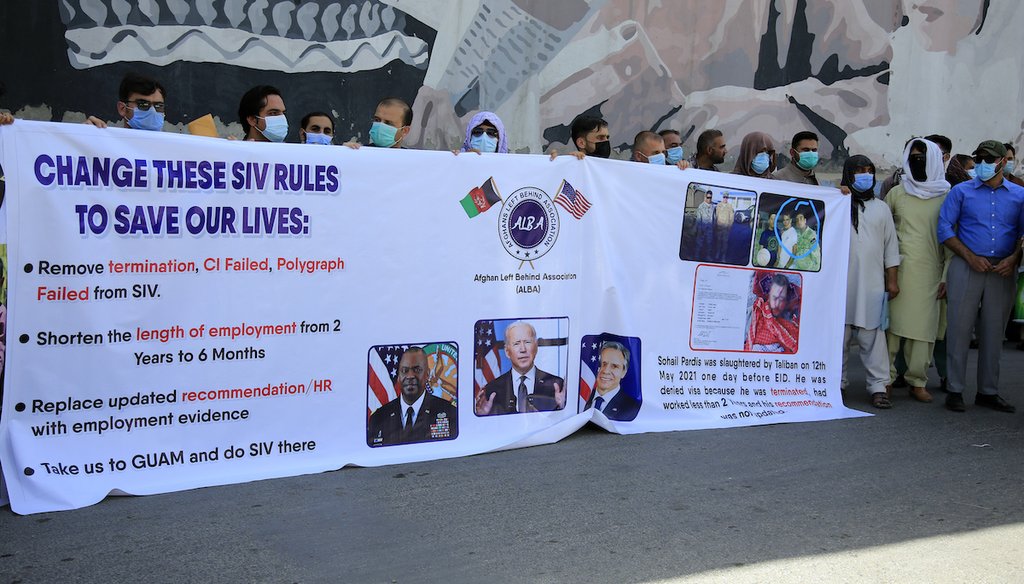

Our only agenda is to publish the truth so you can be an informed participant in democracy.
We need your help.


In this June 25, 2021 photo, former Afghan interpreters hold placards during a demonstrations against the US government, in front of the US Embassy in Kabul, Afghanistan. (AP)
Between January and July, 6,430 Afghans received special immigrant visas.
Most of them were family members of Afghans who worked for Americans.
There’s a backlog of about 18,000 Afghan workers who have started the application process.
As Kabul is evacuated, the fate of the thousands of Afghans who helped American agencies, contractors and the U.S. military during the two decades of American intervention hangs in the balance.
In an interview with ABC’s George Stephanopoulos, President Joe Biden said that despite the sudden collapse of the Afghan government, his administration had been moving quickly to get Afghan workers out of the country. Biden referred in the interview to "SIVs," the special immigrant visas created in 2009 specifically to keep safe those who had helped the American mission in Afghanistan.
"We had already issued several thousand passports to the — the SIVs, the people — the translators when I came into office, before we had negotiated getting out at the end of August," Biden said in the Aug. 18 interview.
The numbers the White House provided as evidence deal with Biden’s time in office, and they only partly back up Biden’s claim. The administration has issued special immigrant visas at an ever faster pace, and the total is over 5,000 since April. But that figure includes family members of the people who worked with the U.S., and Biden’s comments don’t address an estimated 18,000 Afghan workers whose applications are still pending.
Between April and July, the administration issued 5,641 special visas, the White House press office told PolitiFact. Add to that the 789 issued between January and March, and the total on Biden’s watch is 6,430.
But Biden talked about "translators" — which can be read broadly as the workers covered by the special immigrant visa program — and to nail down those numbers would require data on how many actual workers, as opposed to family members, have received visas.
We don’t have firm data on how many of 5,641 are the people who worked with U.S. forces or agencies, but what we do have points to a much lower figure.
The latest State Department report for January through March shows 137 visas issued to the Afghan employees — called principal applicants — and 652 issued to their family members. That suggests that a bit under a fifth of the total were visas for the employees.
A higher fraction came from State Department spokesman Ned Price, when he briefed reporters on a different group of Afghans in the approval pipeline.
Price said that workers were about 700 out of 2,500 applicants who had been approved for entry (but hadn't necessarily received a visa yet). That suggests just under 30% of the total are Afghan employees.
Applying that higher percentage to the 5,641 from April through July, and adding the 137 from the first quarter would suggest that about 1,720 Afghan employees got special visas since January.
Many thousands more are still in line. As of May, there were "approximately 18,000 Afghan principal applicants at some stage of this process," Price at the State Department said.
That process has been difficult, as officials balance the desire to protect workers with the need to weed out impostors and potential terrorists. An application passes through five separate government agencies, bouncing between the embassy in Kabul and offices in the United States. The paperwork requirements are stringent, and for many, employment records no longer exist.
"This makes you realize how much of a miracle it is that anyone receives a special immigrant visa at all," said former U.S. Ambassador to Iraq Ryan Crocker in Senate testimony.
The White House told PolitiFact it had reduced the processing time to an average of nine to 12 months as of May, from two years. The administration has increased the embassy staff to move applications forward. Congress increased the number of special visas by 8,000.
But by one estimate, based on the backlog of 18,000 principal applicants, the U.S. faces the task of vetting over 70,000 visas for workers and their family members.
Biden said that the United States had issued several thousand special visas to Afghan translators who had helped Americans. Based on the available data, the actual number of Afghan employees who have received a visa is likely closer to 1,700.
On the other hand, the total number of Afghans helped is over 6,400, and the administration has sped up the processing time.
There is a backlog of about 18,000 Afghans who worked with Americans who have started the visa application process.
We rate this claim Half True.
ABC News, Full transcript of George Stephanopoulos interview with President Joe Biden, Aug. 19, 2021
U.S. State Department, FY 2021 Q2 Status of the Afghan Special Immigrant Visa Program, April 2021
U.S. State Department, Press Briefing, July 19, 2021
U.S. State Department, Press briefing, July 12, 2021
Carnegie Endowment for International Peace, Special Immigrant Visas for Foreign Interpreters, June 23, 2021
Migration Policy Institute, U.S. Government Rush to Evacuate Afghan Allies and Allocate Sufficient Special Visas Comes at Eleventh Hour, July 27, 2021
U.S. Congress, Afghan Allies Protection Act of 2009 - as amended, July 30, 2021
Reuters, Biden's vow to airlift Afghan allies meets ticking clock, risky rescue, Aug. 17, 2021
Email exchange, Vedant Patel, assistant press secretary, White House press office, Aug. 19, 2021
In a world of wild talk and fake news, help us stand up for the facts.
